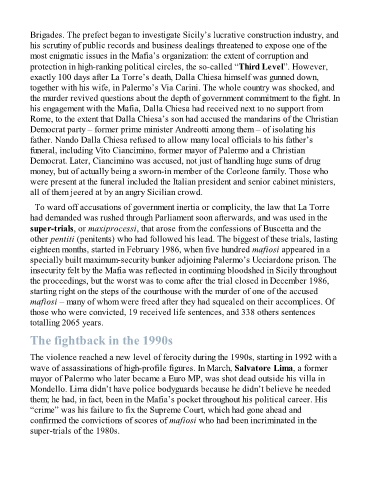Page 579 - The Rough Guide of Sicily
P. 579
Brigades. The prefect began to investigate Sicily’s lucrative construction industry, and
his scrutiny of public records and business dealings threatened to expose one of the
most enigmatic issues in the Mafia’s organization: the extent of corruption and
protection in high-ranking political circles, the so-called “Third Level”. However,
exactly 100 days after La Torre’s death, Dalla Chiesa himself was gunned down,
together with his wife, in Palermo’s Via Carini. The whole country was shocked, and
the murder revived questions about the depth of government commitment to the fight. In
his engagement with the Mafia, Dalla Chiesa had received next to no support from
Rome, to the extent that Dalla Chiesa’s son had accused the mandarins of the Christian
Democrat party – former prime minister Andreotti among them – of isolating his
father. Nando Dalla Chiesa refused to allow many local officials to his father’s
funeral, including Vito Ciancimino, former mayor of Palermo and a Christian
Democrat. Later, Ciancimino was accused, not just of handling huge sums of drug
money, but of actually being a sworn-in member of the Corleone family. Those who
were present at the funeral included the Italian president and senior cabinet ministers,
all of them jeered at by an angry Sicilian crowd.
To ward off accusations of government inertia or complicity, the law that La Torre
had demanded was rushed through Parliament soon afterwards, and was used in the
super-trials, or maxiprocessi, that arose from the confessions of Buscetta and the
other pentiti (penitents) who had followed his lead. The biggest of these trials, lasting
eighteen months, started in February 1986, when five hundred mafiosi appeared in a
specially built maximum-security bunker adjoining Palermo’s Ucciardone prison. The
insecurity felt by the Mafia was reflected in continuing bloodshed in Sicily throughout
the proceedings, but the worst was to come after the trial closed in December 1986,
starting right on the steps of the courthouse with the murder of one of the accused
mafiosi – many of whom were freed after they had squealed on their accomplices. Of
those who were convicted, 19 received life sentences, and 338 others sentences
totalling 2065 years.
The fightback in the 1990s
The violence reached a new level of ferocity during the 1990s, starting in 1992 with a
wave of assassinations of high-profile figures. In March, Salvatore Lima, a former
mayor of Palermo who later became a Euro MP, was shot dead outside his villa in
Mondello. Lima didn’t have police bodyguards because he didn’t believe he needed
them; he had, in fact, been in the Mafia’s pocket throughout his political career. His
“crime” was his failure to fix the Supreme Court, which had gone ahead and
confirmed the convictions of scores of mafiosi who had been incriminated in the
super-trials of the 1980s.

